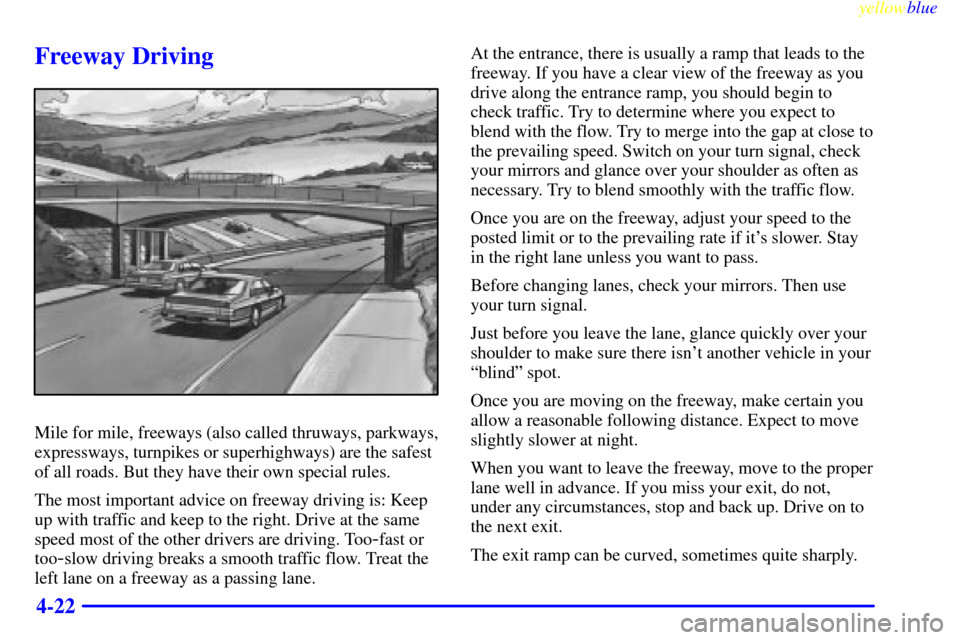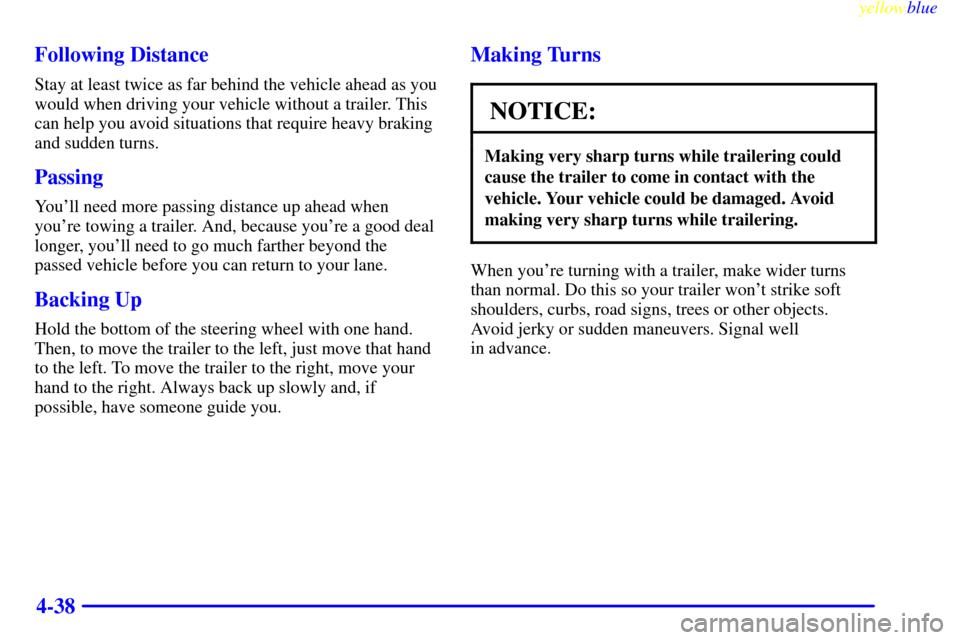Page 165 of 336
yellowblue
4-21
City Driving
One of the biggest problems with city streets is the
amount of traffic on them. You'll want to watch out for
what the other drivers are doing and pay attention to
traffic signals.Here are ways to increase your safety in city driving:
�Know the best way to get to where you are going.
Get a city map and plan your trip into an unknown
part of the city just as you would for a
cross
-country trip.
�Try to use the freeways that rim and crisscross most
large cities. You'll save time and energy. (See the
next part, ªFreeway Driving.º)
�Treat a green light as a warning signal. A traffic light
is there because the corner is busy enough to need it.
When a light turns green, and just before you start to
move, check both ways for vehicles that have not
cleared the intersection or may be running the
red light.
Page 166 of 336

yellowblue
4-22
Freeway Driving
Mile for mile, freeways (also called thruways, parkways,
expressways, turnpikes or superhighways) are the safest
of all roads. But they have their own special rules.
The most important advice on freeway driving is: Keep
up with traffic and keep to the right. Drive at the same
speed most of the other drivers are driving. Too
-fast or
too
-slow driving breaks a smooth traffic flow. Treat the
left lane on a freeway as a passing lane.At the entrance, there is usually a ramp that leads to the
freeway. If you have a clear view of the freeway as you
drive along the entrance ramp, you should begin to
check traffic. Try to determine where you expect to
blend with the flow. Try to merge into the gap at close to
the prevailing speed. Switch on your turn signal, check
your mirrors and glance over your shoulder as often as
necessary. Try to blend smoothly with the traffic flow.
Once you are on the freeway, adjust your speed to the
posted limit or to the prevailing rate if it's slower. Stay
in the right lane unless you want to pass.
Before changing lanes, check your mirrors. Then use
your turn signal.
Just before you leave the lane, glance quickly over your
shoulder to make sure there isn't another vehicle in your
ªblindº spot.
Once you are moving on the freeway, make certain you
allow a reasonable following distance. Expect to move
slightly slower at night.
When you want to leave the freeway, move to the proper
lane well in advance. If you miss your exit, do not,
under any circumstances, stop and back up. Drive on to
the next exit.
The exit ramp can be curved, sometimes quite sharply.
Page 182 of 336

yellowblue
4-38 Following Distance
Stay at least twice as far behind the vehicle ahead as you
would when driving your vehicle without a trailer. This
can help you avoid situations that require heavy braking
and sudden turns.
Passing
You'll need more passing distance up ahead when
you're towing a trailer. And, because you're a good deal
longer, you'll need to go much farther beyond the
passed vehicle before you can return to your lane.
Backing Up
Hold the bottom of the steering wheel with one hand.
Then, to move the trailer to the left, just move that hand
to the left. To move the trailer to the right, move your
hand to the right. Always back up slowly and, if
possible, have someone guide you.
Making Turns
NOTICE:
Making very sharp turns while trailering could
cause the trailer to come in contact with the
vehicle. Your vehicle could be damaged. Avoid
making very sharp turns while trailering.
When you're turning with a trailer, make wider turns
than normal. Do this so your trailer won't strike soft
shoulders, curbs, road signs, trees or other objects.
Avoid jerky or sudden maneuvers. Signal well
in advance.
Page 183 of 336

yellowblue
4-39 Turn Signals When Towing a Trailer
When you tow a trailer, your vehicle may need a
different turn signal flasher and/or extra wiring. Check
with your dealer. The arrows on your instrument panel
will flash whenever you signal a turn or lane change.
Properly hooked up, the trailer lamps will also flash,
telling other drivers you're about to turn, change lanes
or stop.
When towing a trailer, the arrows on your instrument panel
will flash for turns even if the bulbs on the trailer are burned
out. Thus, you may think drivers behind you are seeing your
signal when they are not. It's important to check occasionally
to be sure the trailer bulbs are still working.
Driving On Grades
Reduce speed and shift to a lower gear before you start
down a long or steep downgrade. If you don't shift
down, you might have to use your brakes so much that
they would get hot and no longer work well.
On a long uphill grade, shift down and reduce your
speed to around 45 mph (70 km/h) to reduce the
possibility of engine and transaxle overheating.
If you are towing a trailer, you may prefer to drive in
DRIVE (D) instead of AUTOMATIC OVERDRIVE (�)
(or, as you need to, a lower gear).
Parking on Hills
CAUTION:
You really should not park your vehicle, with a
trailer attached, on a hill. If something goes
wrong, your rig could start to move. People can
be injured, and both your vehicle and the trailer
can be damaged.
But if you ever have to park your rig on a hill, here's
how to do it:
1. Apply your regular brakes, but don't shift into
PARK (P) yet.
2. Have someone place chocks under the trailer wheels.
3. When the wheel chocks are in place, release the
regular brakes until the chocks absorb the load.
4. Reapply the regular brakes. Then apply your parking
brake, and then shift to PARK (P).
5. Release the regular brakes.
Page 186 of 336
yellowblue
5-2
Hazard Warning Flashers
Your hazard warning flashers let you warn others. They
also let police know you have a problem. Your front and
rear turn signal lamps will flash on and off.
Press the switch (located near the ignition switch) to
make your front and rear turn signal lamps flash on and
off. Your hazard warning flashers work no matter what
position your key is in, and even if the key isn't in.
To turn off the flashers, press the switch again. When
the hazard warning flashers are on, your turn signals
won't work.
Other Warning Devices
If you carry reflective triangles, you can set one up at
the side of the road about 300 feet (100 m) behind
your vehicle.
Page 254 of 336
yellowblue
6-34
4. Install the electrical connector to the bulb.
5. Install the new bulb by inserting the smallest tab
on the bulb base into the matching notch in the
retaining ring. Turn the bulb a quarter
-turn clockwise
until it stops.
6. Close the hood.
Front Parking and Turn Signal Lamp
1. Open the hood. There is one flap on each side of
the radiator.
2. Open the flap by lifting the tab.
Page 256 of 336
yellowblue
6-36 Center High-Mounted Stoplamp
To reach the center high-mounted stoplamp, you must
go through the trunk.
1. Open the trunk lid. Locate the stoplamp behind the
rear seats, in front of the trunk hinges.
2. Turn the socket counterclockwise until it stops and
pull the bulb and socket out of the assembly.3. Push in the bulb, turn it counterclockwise and pull it
out of the socket.
4. Push the new bulb into the socket and turn
it clockwise.
5. Replace the bulb and socket in the assembly.
Tail/Stop/Turn Signal Lamp
1. Open the trunk. Remove the convenience net if you
have one. Unhook the net from the upper wing nut.
2. Remove the upper
convenience net wing
nut, if equipped.
3. Pull the carpet away from the rear of the vehicle.
Page 278 of 336

yellowblue
6-58
Fuse Description
12 Anti
-Theft/PCM -- Theft-Deterrent
Module, Powertrain Control Module,
(PCM) IGN System Relay
13 ABS
-- Electronic Brake Control
Module (EBCM), ABS Relay
14 HVAC Blower Motor
-- Blower
Motor Relay
15 L.H. Spot Lamp (S.E.O.)
16 Steering Wheel Control #1
-- Steering
Wheel Radio Control Lighting
17 Not Used
18 Not Used
19 Power Accessory #1
-- Door Lock
Switches, Trunk Courtesy Lamp, O/S
Mirror Switch, (S.E.O.) Emergency
Vehicle
-Rear Compartment Lid Lamp or
Window Panel Lamps
20 Steering Wheel Control #2
-- Steering
Wheel Radio ControlsFuse Description
21 Air Bag
-- Air Bag System
22 Cruise Control
--Cruise Control Cut-Out
Switch, Cruise Control Module, Turn
Signal Cruise Control Switches
23 Stoplamps
-- Stoplamp Switch (Brake)
24 Not Used
25 English/Metric (S.E.O.)
26 Not Used
27 Not Used
28 CTSY Lamps
-- Vanity Mirrors, I/P
Compartment Lamp, I/S Lighted
Rearview Mirror, Dome Lamp
29 Wiper
-- Wiper Switch
30 Turn Signal
-- Turn Signal Flasher
31 Not Used
32 Power Locks
-- Door Lock Relay,
Remote Keyless Entry Receiver